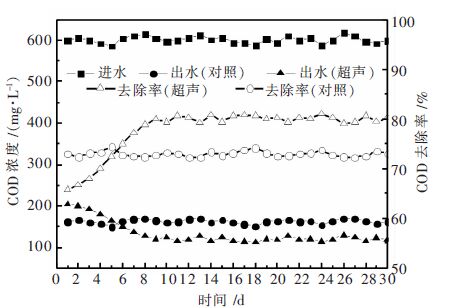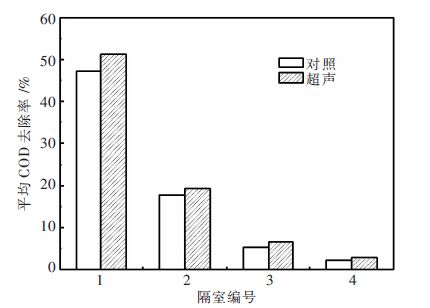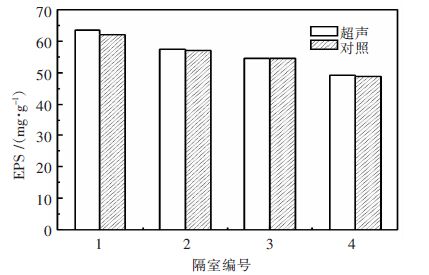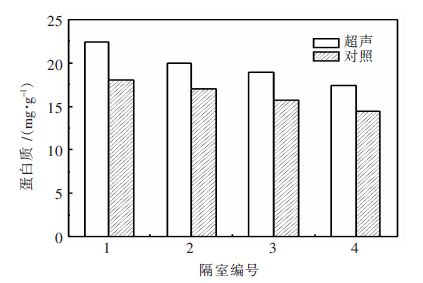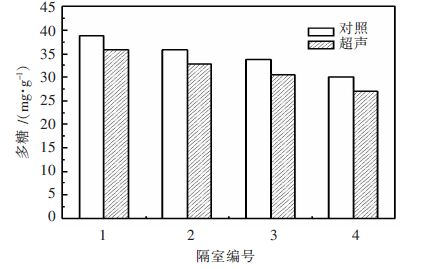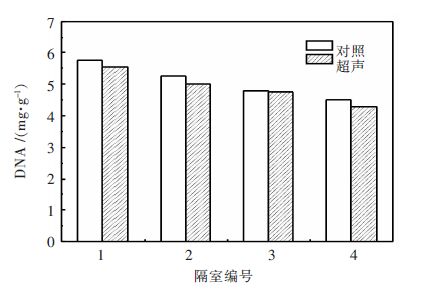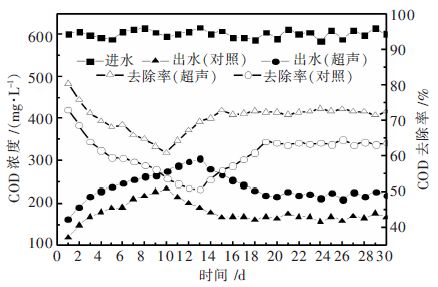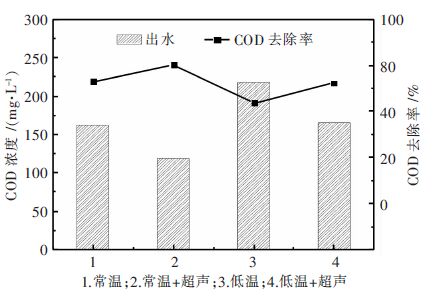Treatment of low concentration sewage by low intensity ultrasonic strengthen ABR
-
摘要: 为提高ABR (厌氧折流板反应器)对低浓度污水的处理效果,通过设置超声组和对照组ABR 的对比试验,考察低强度超声波对ABR 处理低浓度污水的强化效果.结果表明,当采用声能密度为 0.1 W/mL 的超声波,每隔24 h 从ABR 中各隔室内取出10 %的污泥进行10 min 的辐照处理时,平均 COD 总去除率提高7.2 %左右. 通过该辐照处理,ABR 中各隔室内的胞外聚合物总量基本不变尧蛋 白质的含量有所提高尧多糖的含量有所降低尧DNA 的含量变化不大尧颗粒污泥的粒径减小. 研究还发 现,低温条件下,超声组ABR 的平均COD 去除率比对照组提高了8.6 豫,只低于常温条件下对照组 0.7 豫.低温条件下的超声强化效果比常温条件下更显著,而且超声组ABR 比对照组提前4 d 恢复稳 定运行.Abstract: To improve the treatment effect of ABR (anaerobic baffled reactor) for low concentration wastewater, the effect of low intensity ultrasound on the treatment of low concentration wastewater was studied by perform- ing a contrast test of ABR in ultrasonic group and control group. The results show that when using the energy density of 0.1 W/mL ultrasonic every 24 h from each compartment of ABR removed 10 % sludge for 10 min of irradiation processing, the average removal rate of COD increased by about 7.2 %. By this irradiation, the total amount of extracellular polymeric in each compartment of ABR is essentially the same, the content of protein is increased, the content of polysaccharides is reduced, the content of DNA changes little, and the particle size of granular sludge is decreased. It is also found that the average COD removal rate of ABR in the ultrasonic group is 8.6 percentage points lower than that in the control group at low temperature, which is only 0.7 per- centage points lower than that in the control group. Under low temperature condition, the strengthening effect of ultrasound is more significant than that of normal temperature袁and the ABR of the ultrasound group is 4 days earlier than the control group to resume stable operation.
-
ABR作为一种高效的厌氧生物处理工艺,不仅在处理中高浓度有机废水方面取得一系列的研究成果,而且在处理低浓度废水方面也受到越来越广泛的关注[1-4]. 但是厌氧生物处理低浓度废水存在一些急需解决的问题,例如:废水温度低和有机物浓度梯度低造成的厌氧微生物的比生长速率及对基质的比降解速率低,产气量少无法进行有效的搅拌混合液和低温加大水的黏度导致固液传质效率低,产甲烷菌的生存条件苛刻和倍增长速率周期长导致微生物活性不高和反应器启动周期长等[5-7]. 针对这些问题,国内外学者进行了大量的研究,其中利用低强度超声波强化污泥活性得到较多的关注[8-9]. 研究表明,低强度超声波可以有效地促进传质、增加酶活性和加速细胞生长[10]. 所以在污水生物处理过程,可利用低强度超声波来提高微生物的活性,从而提高污水生物处理的效率.
闫怡新等[11]研究表明,当超声辐照强度、超声辐照时间、超声辐照间隔周期和超声辐照处理污泥比例分别为0.3 W/cm2、10 min、8 h和10 %时,低强度超声波可以使SBR的COD去除效果得到进一步的提高,低强度超声波也可以减小冲击负荷和有毒物质对SBR产生的不利影响. 何慧等[12]利用超声强化SBR.结果表明,与对照组SBR相比,超声组SBR对COD、TN和TP等的去除率有所提高,处理后的水质较好. Chu等[13]对活性污泥进行厌氧消化之前,先用一定强度的超声波对其进行辐射照化. 研究发现,甲烷产量提高的幅度很大,而且也没有使污泥的结构遭到破坏. 谢倍珍等[14]利用厌氧污泥脱氢酶的活性和辅酶F420的含量作为参考指标,研究不同的超声辐照参数对污水厌氧生物处理的影响. 研究发现,最佳超声声能密度为0.2 W/cm2、最佳超声时间为10 min,而且在最佳超声辐照参数的作用下,出水COD更低,COD去处率提高的幅度较大. Zhu等[15]研究低强度超声波强化ABR处理低浓度污水的启动. 结果表明,当超声声能密度为0.1 W/mL、超声辐照时间为10 min时,污泥活性达到最大,ABR的启动时间变短、COD的去除率也得到提高.
虽然低强度超声波对污水生物处理的促进作用已经被大量的研究所证实,但是不同的研究者所得出的结论差别较大,这主要是因为微生物群体结构的多样性、微生物生长环境的差异性和低强度超声波强化微生物活性的影响因素众多所导致的. 为了更好地揭示低强度超声波强化污水厌氧生物处理的规律,课题组前期针对超声强化低浓度污水厌氧生物处理进行相应的研究[16],试验污泥采用自制改良型ABR反应器培养得到. 本研究通过超声组和对照组ABR进行比较,考察低强度超声波对ABR处理低浓度污水和抗低温的影响,并对ABR中各隔室内的污泥形态、EPS的分泌和释放进行研究.
1 实 验
1.1 实验用水
实验用水采用人工配制的污水,控制进水COD在600 mg/L左右,以葡萄糖为碳源,向配水中投加适量氯化铵和蛋白胨为氮源、磷酸二氢钾为磷源,以保证进水所需C∶N∶P营养比,并投加适量的NaHCO3调节碱度,微量元素母液的投加量为0.25 mL/L.
1.2 实验装置
设计制作结构和尺寸完全相同的2个ABR,长、宽和高分别为400 mm、100 mm和400 mm,具有4个隔室,实际有效长、宽和高分别为400 mm、100 mm和300 mm,实际有效体积为12 L,折流板夹角为45°,上流室与下流室的宽度比为1∶4,上流室长宽比为1∶1.25.每个隔室顶部预留超声污泥回流孔,每个隔室离底面30 mm与270 mm处设置一个污泥取样口以及一个水样取样口,圆孔直径为10 mm.整个装置采用厌氧密闭方式,进水方式采用蠕动泵控制.
实验所用超声波处理装置为宁波海曙科生超声设备有限公司生产的 KS-250型探头式超声波细胞粉碎机,超声发生频率为20 kHz,电功率为0~250 W(可调),钛合金探头直径为9 mm,超声辐照方式为间歇式,常压操作.超声探头置于污泥液面以下1 cm. 实验装置流程图如图 1所示.
1.3 实验方法
在2组ABR污泥接种后,经过44 d的驯化后,ABR启动成功.此时两组ABR的水力停留时间为8 h,COD去除率稳定在73 %左右,污泥性质基本稳定. 此时对其中一组ABR进行超声辐照处理,每隔24 h从该ABR中各隔室内取出10 %的污泥,用超声声能密度为0.1 W/mL的超声波进行10 min的超声处理,待超声完成后,分别将污泥回流至各隔室. 另一组ABR作为对照组.
每天测定超声组和对照组ABR的出水COD,待ABR运行稳定后,分别取样测定超声组和对照组ABR的出水COD和各隔室内的COD、胞外聚合物的总量、蛋白质的含量、多糖的含量和DNA的含量和污泥形态.
在冬季12月份(平均气温7~15 ℃),将室内空调关闭,使超声组和对照组ABR 开始在低温条件下运行.每天测定超声组和对照组ABR 的出水COD,直至超声组和对照组ABR 运行稳定为止.
1.4 测定方法
COD采用快速密闭催化消解法测定,挥发性固体悬浮物(VSS)采用重量法测定,胞外聚合物(EPS)采用热提取法测定,蛋白质采用考马氏亮蓝法测定,多糖采用苯酚-硫酸法测定,DNA采用二苯胺显色法测定,污泥形态采用生物显微镜观测法测定.
2 结果与讨论
2.1 超声对ABR反应器的出水COD和各隔室内COD降解的影响
超声组和对照组ABR的进出水COD和COD去除率如图 2所示,各隔室平均COD去除量如图 3所示. 当进水COD为600 mg/L左右时,对照组ABR的平均出水COD始终维持在162 mg/L左右,COD的总去除量为438 mg/L,平均COD去除率为73 %. 其中,1号隔室的平均COD去除量为283 mg/L,占整个ABR COD去除量的64.6 %;2号隔室的平均COD去除量为108 mg/L,占整个ABR COD去除量的24.7 %;3号隔室的平均COD去除量为33 mg/L,占整个ABR COD去除量的7.5 %;4号隔室的平均COD去除量为14 mg/L,占整个ABR COD去除量的3.2 %. 而超声组ABR的出水COD在运行初期(第1天至第8天)不断发生变化,在施加低强度超声波作用后的第一天,超声组ABR的出水COD为205 mg/L,COD的总去除量为395 mg/L,COD的去除率为65.8 %,比对照组ABR降低7.2 %. 这主要是因为运行初期ABR处于调整适应期,对ABR中厌氧污泥的超声回流使得微生物种群受到扰动,这种扰动在一定程度上打破了原来有机污染物的降解平衡,所以出水COD会有一定程度的变化.
经过8 d的调整适应期之后,超声组ABR的平均出水COD稳定在119 mg/L左右,COD的总去除量为481 mg/L,COD的去除率为80.2 %. 其中,1号隔室的平均COD去除量为308 mg/L,占整个ABR COD去除量的64.0 %;2号隔室的平均COD去除量为117 mg/L,占整个ABR COD去除量的24.3 %;3号隔室的平均COD去除量为40 mg/L,占整个ABR COD去除量的8.3 %;4号隔室的平均COD去除量为16 mg/L,占整个ABR COD去除量的3.4 %. 由于ABR具有多个隔室,而且其整体为推流式,进水是低浓度污水,各隔室的容积负荷沿着水流方向逐渐降低,可被厌氧微生物所利用的有机物逐渐减少,所以从1号隔室到4号隔室的COD降解量逐渐减少. 由于ABR前两个隔室内的厌氧微生物对有机物具有优先选择权,厌氧微生物的活性较高,所以COD的去除主要发生在前两个隔室. 而后两个隔室的容积负荷较低,厌氧微生物处于饥饿状态,微生物的活性较低,COD去除率也都在10 %以下.
超声组和对照组ABR在前两个隔室的去除率上大致相同,占到总去除率的90 %左右,超声并没有影响各隔室之间的资源占用情况,但是超声组各隔室在COD降解量上都高于对照组. 这主要是因为实验中所采用的低强度超声波会对微生物细胞表面产生微小的创伤,使细胞壁局部发生破裂,这种微小的创伤是微生物细胞可以承受的,微生物细胞在其本能防御反应的作用下开始对伤口进行自我修复,在对伤口的自我修复过程中,酶的分泌增多,细胞新陈代谢加快,微生物的活性得以增强[17-18].
厌氧生物处理工艺之所以难以广泛地应用于工程当中,其重要的原因之一是出水COD较高,从试验结果可以看出,通过超声可以有效地降低出水COD的值.
2.2 超声对ABR各隔室内EPS分泌和释放的影响
EPS是活性污泥的重要组成部分,它是微生物在生长代谢过程中根据自身所处的环境而分泌出来的一种非均相物质,对菌胶团结构的稳定性和污泥絮体的沉降性有着很大的影响,是活性污泥生长代谢过程中不可缺失的重要组成部分[19]. 它既是营养物质的输送通道,又是在营养物质匮乏的时候的备用碳源,其含量反映污泥中微生物特性及构成的变化,进而影响到污泥特性和系统的处理效果[20]. 所以通过对胞外聚合物的研究,可以了解到污泥的生长及代谢情况.
超声组和对照组ABR中各隔室内胞外聚合物的总量如图 4所示.超声组和对照组ABR在相同隔室内的胞外聚合物总量相差无几,这说明超声并不会改变胞外聚合物的总量. 超声组和对照组ABR从1号隔室到4号隔室的胞外聚合物总量都逐渐降低,这可能与ABR中各隔室内的容积负荷有关,随着ABR中各隔室内的容积负荷逐渐降低,胞外聚合物的总量也逐渐降低.在容积负荷较高的隔室内,胞外聚合物作为营养物质的载体,吸附污水中的有机污染物,所以胞外聚合物的总量相对较高. 然而在容积负荷较低的隔室内,一部分胞外聚合物作为碳源被微生物分解利用,所以胞外聚合物的总量相对较低.
超声组和对照组ABR中各隔室内蛋白质的含量如图 5所示. 超声组和对照组ABR从1号隔室到4号隔室的蛋白质含量都逐渐降低,与对照组相比,超声组ABR中各隔室内的蛋白质含量都有一定程度的提高,这说明超声能够使得胞外聚合物中的蛋白质含量提高. 这可能是因为低强度超声辐照使得微生物细胞表面产生微小的创伤,微生物细胞在对伤口的自我修复过程中分泌出大量的酶蛋白,用以完成各种生物合成反应[17-18]. 这种微小的创伤不仅不会导致细胞死亡,而且还会激发细胞的自我修复功能,从而促进微生物细胞对蛋白质的合成.
超声组和对照组ABR中各隔室内多糖的含量如图 6所示.超声组和对照组ABR从1号隔室到4号隔室的多糖含量都逐渐降低,与对照组相比,超声组ABR中各隔室内的多糖含量都有一定程度的降低,这说明超声导致胞外聚合物中的多糖含量降低.这可能是因为低强度超声辐照干扰微生物细胞对糖类物质的转换和合成,或者由于低强度超声辐照使得微生物细胞表面产生微小的创伤,微生物细胞在对伤口的自我修复过程中消耗一部分多糖,从而导致多糖含量的降低.
超声组和对照组ABR中各隔室内DNA的含量如图 7所示.超声组和对照组ABR从1号隔室到4号隔室的DNA含量都逐渐降低,这个与胞外聚合物总的提取量有关.超声组和对照组ABR在相同隔室内的DNA含量基本相同,这主要是因为DNA占胞外聚合物总量的比重都在9 %左右,DNA主要来源于细胞胞内物质的释放(细胞自溶),而低强度超声辐照并不会导致细胞大面积死亡.
2.3 超声对ABR各隔室内污泥形态的影响
厌氧颗粒污泥中所具有的微生物是由产乙酸菌和产甲烷菌等组成的,常见的颗粒污泥一般为椭圆状和多孔结构. 对照组和超声组ABR中各隔室内污泥形态如图 8和图 9所示. 超声组和对照组ABR从1号隔室到4号隔室内的颗粒污泥粒径都逐渐减小.其中,在对照组中,与2号隔室、3号隔室和4号隔室相比,1号隔室内的厌氧颗粒污泥中的菌胶团数量较多、絮体结构较致密;而在超声组中,与2号隔室、3号隔室和4号隔室相比,也是1号隔室内的厌氧颗粒污泥中的菌胶团数量较多、絮体结构较致密. 这主要是因为ABR从1号隔室到4号隔室的污染物浓度逐渐降低,1号隔室内的微生物对污染物具有优先选择权,厌氧微生物的活性较高,大多数有机底物被1号隔室内的厌氧微生物所去除,所以1号隔室在有机污染物去除上起主导作用,这也是造成1号隔室内的颗粒污泥粒径较大、菌胶团数量较多和絮体结构较致密的主要原因.
在对照组中,1号隔室和4号隔室内厌氧颗粒污泥的颜色为深黑色,2号隔室和3号隔室内厌氧污泥为灰色,这可能与ABR的运行条件和进水中加入的微量元素有关;而在超声组中,1号隔室和4号隔室内厌氧颗粒污泥的颜色更接近于灰色,这可能是低强度超声波的辐照处理使厌氧颗粒污泥中的菌胶团遭到破坏、絮体结构变得松散和胞外聚合物的组成发生变化等原因所导致. 在相同隔室内,与对照组相比,超声组ABR中的颗粒污泥粒径较小、菌胶团数量较少和絮体结构较松散,这主要是因为低强度超声波的辐照处理打散了活性污泥絮体,使它的颗粒变小、结构更松散. 由此可见,低强度超声波不仅不会破坏细胞结构,反而增加污泥絮体与混合液液相接触的面积,在一定程度上强化固相和液相对氧的传质能力,增加厌氧污泥对混合液中营养基质的利用能力.
2.4 超声对ABR抗低温的影响
低温条件下,超声组和对照组ABR的进出水COD和COD去除率如图 10所示. 低温和常温条件下,超声组和对照组ABR在稳定运行后,出水COD和COD去除率如图 11所示. 当超声组和对照组ABR开始在低温条件下运行时,超声组和对照组ABR 的出水COD都开始明显增加.其中,对照组ABR 的出水COD从第1天的162 mg/L增加到第 13天的304 mg/L,COD去除率从73 %下降到50.7 %;超声组ABR 的出水COD从第1天的119 mg/L增加到第10天的233 mg/L,COD去除率从80.2 %下降到61.2 %.这主要是因为在低温时,水中黏度变大,导致微生物和有机污染物之间传质效率降低;厌氧微生物的酶催化作用受到抑制,导致微生物的活性降低,对水中有机污染物的降解速度也变慢,所以ABR 的出水COD增加.
超声组和对照组ABR 的出水COD在达到最高后便不再增加,之后开始有一定的降低.其中,对照组ABR 的出水COD从第13天的304 mg/L降低到第19天的218 mg/L,COD去除率从50.7 %提高到63.7 %;超声组ABR 的出水COD从第10天的233 mg/L降低到第15天的166 mg/L,COD去除率从61.2 %提高到72.3 %. 这可能是由于ABR 中各隔室内的微生物慢慢地适应了温度由常温降低到低温,而且低温时的优势菌种也开始发挥较大的作用.
从第19天开始,对照组ABR恢复稳定运行,平均出水COD为218 mg/L,比常温条件下提高了56 mg/L;平均COD去除率为63.7 %,比常温条件下降低9.3 %. 从第15天开始,超声组ABR恢复稳定运行,平均出水COD为166 mg/L,比对照组降低52 mg/L,只比常温条件下对照组高出4 mg/L;平均COD去除率为72.3 %,比对照组提高8.6 %,只低于常温条件下对照组0.7 %. 在低温时,通过低强度超声波强化后,COD的去除率明显增加,厌氧污泥的活性也增加到与常温时的对照组相差不大,低温条件下的超声强化效果比常温条件下更显著,而且超声组ABR比对照组提前4 d恢复稳定运行. 这主要是因为本实验中所采用的低强度超声波会对微生物细胞表面产生微小的创伤,使细胞壁局部发生破裂,这种微小的创伤是微生物细胞可以承受的,微生物细胞在其本能防御反应的作用下开始对伤口进行自我修复,在对伤口的自我修复过程中,酶的分泌增多,细胞新陈代谢加快,微生物的活性得以增强[17-18].
3 结 论
1)与对照组相比,超声组ABR的平均出水COD降低43 mg/L、平均COD去除率提高7.2 %,通过低强度超声波的辐照作用,有效地提高了ABR对低浓度污水的处理能力.
2)超声组和对照组ABR中各隔室内的胞外聚合物总量、蛋白质含量、多糖含量和DNA含量都沿着水流方向逐渐降低,通过低强度超声波的辐照处理,ABR中各隔室内的胞外聚合物总量基本不变、蛋白质的含量有所提高、多糖的含量有所降低、DNA的含量变化不大.
3)超声组和对照组ABR中各隔室内的颗粒污泥粒径都沿着水流方向逐渐减小,低强度超声波使得ABR中各隔室内的颗粒污泥粒径减小、絮体结构更松散.
4)低温条件下,超声组ABR 的平均COD 去除率比对照组提高了8.6 %,只低于常温条件下对照组0.7 %.低温条件下的超声强化效果比常温条件下更显著,而且超声组ABR 比对照组提前4 d恢复稳定运行.
-
-
[1] 赵金安,雷英春.ABR反应器处理畜禽养殖废水中厌氧污泥颗粒化的研究[J].中北大学学报,2015,36(1):75-79. http://www.cnki.com.cn/Article/CJFDTOTAL-HBGG201501015.htm [2] KRISHNA GVTG, KUMAP P, KUMAR P. Complex wastewater treatment using an anaerobic baffled reactor[J]. Environment Pro-gress, 2007, 26(4): 391-398. doi: 10.1002/(ISSN)1547-5921
[3] 杜接弟,王毅力,李炯,等.HRT对ABR处理低浓度废水的效果和颗粒污泥特征的影响[J].环境科学,2009,30(7):2022-2029. http://www.cnki.com.cn/Article/CJFDTOTAL-HJKZ200907027.htm [4] 欧阳勇.低浓度废水处理的研究进展[J].广西轻工业, 2009,1(12):19-23. http://www.cnki.com.cn/Article/CJFDTOTAL-GXQG200901045.htm [5] 赵来利,佘宗莲,高孟春,等. 常温下ABR处理低浓度废水性能及污泥特性[J]. 环境工程学报, 2010, 4(4):761-766. http://www.cnki.com.cn/Article/CJFDTOTAL-HJJZ201004007.htm [6] 郭昱廷,彭剑峰,宋永会,等.温度对 ABR 反应器处理效果和微生物群落结构的影响[J].环境科学学报, 2012, 32(7): 1542-1548. http://www.cnki.com.cn/Article/CJFDTOTAL-HJXX201207003.htm [7] 余亚琴,吕锡武,吴义锋.改进型ABR处理太湖富藻水启动研究[J].湖南大学学报, 2014, 41(3):94-100. http://www.cnki.com.cn/Article/CJFDTOTAL-HNDX201403017.htm [8] XIE B Z,WANG L,LIU H. Using low intensity ultrasound to improve the efficiency of biological phosphorus removal[J]. Ultrasoncs Sonochemistry, 2008, 15(5): 775-781. doi: 10.1016/j.ultsonch.2008.02.001
[9] XIE B Z,LIU H,YAN Y X. Improvement of the activity of anaerobic sludge by low intensity ultrasound[J]. Journal of Environme-ntal Management, 2008, 90 (1): 260-264. http://cn.bing.com/academic/profile?id=2091448713&encoded=0&v=paper_preview&mkt=zh-cn
[10] 谢倍珍,刘红,阎怡新,等.低强度超声波强化污水生物处理理论与技术[M].北京:科学出版社, 2013: 73-83. [11] 闫怡新,刘红,张山立,等.低强度超声波强化SBR处理生活污水[J].环境科学, 2006, 27(8):1596-1602. http://www.cnki.com.cn/Article/CJFDTOTAL-HJKZ200608021.htm [12] 何慧,郑敏,付宏祥,等.超声—SBR组合工艺去除污染物和污泥减量效果研究[J].2013(增刊1): 151-154. [13] CHU C P,LEE D J,CHANG B V,et al. Weak ultrasonic pretreatment on anaerobic digestion of flocculated activated biosolids[J].Water Research, 2002, 36(2): 681-688. http://cn.bing.com/academic/profile?id=2044601418&encoded=0&v=paper_preview&mkt=zh-cn
[14] 谢倍珍,刘红.超声波强化污水厌氧生物处理综述[J].环境污染与防治, 2006, 28(4):267-269. http://www.cnki.com.cn/Article/CJFDTOTAL-HJWR200604008.htm [15] ZHU Y C, LI X, DU M A, et al. Promotion of anaerobic baffled reactor in the treatment of low concentration sewage by low energy ultrasonic irradiation [J]. International Journal of Earth Science and Eenineering, 2014,7(6): 2528-2536. http://www.baidu.com/link?url=VTP49aMqS6zcOs7EL_PemDIwanCu5oihF2as20OqVyYDtTXFRnuVgbPQYPQMk_TcqMVbkGx16vufDNn8qFk6uqT0Ls03Gol4rYEyLCEiNQWntPoW5P_Nmxbi09k4NaWIpBH_AQtJiXutr7PO7C4nQV_TsjQbuFKlAIDtEWwouwVTZTTb7uUF7uMT-My3cff-D6VGd1VSofINHrdfGdnoLRTqIgAlfcR6g55QIxWWQCJZa3t1YQ_sCirEAlenFf5v-DM3hpnj873hFeLnMkoe0g9UUadfonPJReGfEAphI5TYr3kj34Gj9ls7ECKKWWoamxBvRi8OkzQOmWVi98ognX7L4hBRkidpif1DHXCQKshpl8eE4b6M6eJt2uNlSG1pfCJcfYLf0RWmf-UBWaKNXq&wd=&eqid=93a903830002a0e9000000055819519f
[16] 朱易春,李欣,杜茂安,等.低强度超声辐照对厌氧污泥性能的影响[J].中国给水排水, 2015, 11(21):84-88. http://www.cnki.com.cn/Article/CJFDTOTAL-GSPS201521008.htm [17] 闫怡新,刘红.低强度超声波强化污水生物处理中超声辐照周期的优化选择[J].环境科学, 2006, 27(5):898-902. http://www.cnki.com.cn/Article/CJFDTOTAL-HJKZ200605013.htm [18] 刘红,闫怡新,王文燕,等.低强度超声波改善污泥活性[J].环境科学, 2005, 26(4):124-128. http://www.cnki.com.cn/Article/CJFDTOTAL-HJKZ200504024.htm [19] 关玮,肖莆,周晓铁.污泥中胞外聚合物(EPS)的研究进展[J].化学工程, 2009, 23(6):35-39. http://www.cnki.com.cn/Article/CJFDTOTAL-HXGC200906015.htm [20] 曹秀芹,赵自玲.胞外聚合物(EPS)构成的影响因素分析[J].环境科学与技术, 2010, 33(12):420-424. http://www.baidu.com/link?url=ceX1RMQ1YxTgDe1SA2HrTQKePiU5zZL6mY_PRymQbO9rAaWBo4gwL_hSUcVOoxEo95PeGsMtpoHneqKPcG1IH6xgFCjvDbOCv87aZBHH7Xh71E2oiei-Qy1a1XYsKUixOcjob3aPDyJgisvwYv5dhox8oXJhSI7s3slxisWxPIMq6mUYhWDYBRqx5pkzBpsn84MFi--6ZJbInoW5DA2iHODxcmmkZ7NyoUPTVtn8-QBS4Jx8fXEjoZXJTbGXzs25uyBm0Hz6umI_3CXhkO6AzLLKOnrv08fWVbz9cWArQuWSNnUSFcZqcPSmQTn5OMGIrwoAKp3HtDlJYnfUy4IhNnEgzz5BO8YPUCrb5QCJG0bwOMhzzieRwXqfgH0ZxOMjzVW64W_xKg7IFzQGkm2-oKoA0XZUsL7saYk9vU1AFxS&wd=&eqid=9071621f0002c25400000005581951cf




 下载:
下载:
